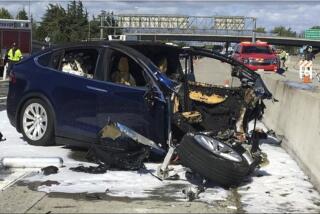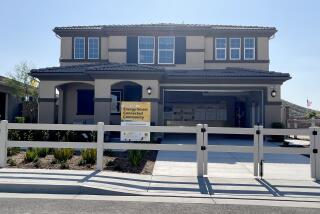Automated âSmartâ House Still a Dream : Common Electronic Language to Link Appliances Would Open the Door to High-Tech Living
Your children like their rooms warm and cozy. You like a brisk environment.
No problem. Your homeâs thermostat can be programmed to deliver the exact level of heating or cooling desired in each room.
Youâre on the freeway when you realize the coffee pot is still on. But, instead of frantically rushing back, you call and tell your home management controller to cut off the juice to the coffee pot.
At the end of a rough day, all you can think about is soaking in a hot bath. Itâs easy. When you reach your freeway exit, call your bath tub--if you have an electronic tub, you probably have a cellular phone--and tell it to be full of 103-degree water by your 7 p.m. arrival.
The house that can take care of itself, as well as its occupants, has been a gleam in the eye of futurists and science fiction writers for decades. But although the above examples of what a âsmartâ house can do are real and available today, the truly automated, electronic house is still more dream and gleam than bricks and mortar.
âItâs still a question more of potential than actuality,â said Christopher Jackson of the Yankee Group, a Boston high-tech market analysis company. âItâs still at least five to 10 years into the future.â
Perhaps the biggest obstacle blocking full-scale development and sales of smart household devices is the lack of a commonly accepted electronic language uniting the various appliances and systems.
Common languages, or formats, are essential to mass technology. Electrical wiring comes in AC (alternating current) and DC (direct current) varieties. Videocassette recorders are available in VHS or Beta tape formats. Even personal computers, one of the youngest industries around, are already grouped around the software program MS-DOS and âall others.â
French Versus Spanish
But home automation system makers have yet to agree on uniform communication standards. And, as a result, virtually all home automation systems offer only one-way communication: from the central controller or household âbrainâ to the individual appliances, such as the self-filling bath tub. And the level of communication is limited to basic on/off commands.
Two-way communication--when the tub tells the controller that it is broken and canât fill itself--isnât available unless the controller speaks the same electronic language as the appliances it wants to talk to.
Manufacturers have been reluctant to make smart devices for fear that they might invest heavily in appliances that speak the electronic equivalent of French when the common standard might turn out to be Spanish. However, industry insiders, who have been predicting an imminent solution for several years, remain hopeful that 1988 will finally produce a standard.
Meanwhile, about half a dozen companies throughout the country have taken the lead and developed fully integrated home automation systems that link four key elements of home life: security, energy management, entertainment and telecommunications.
Currently, the link typically comes from an extra set of wires that a ties a central controller with a variety of sensors and electrical outlets throughout the house. Telephone communication is handled via digital signals that are initially sent through the central controller and then through the wires to the appropriate outlet.
In the future, researchers say, the link will be handled by a common bundle of cords--including telephone, electrical, cable TV and security wires--that run throughout the house.
Although this future smart house will be wired similarly to a conventional one, the key difference is that smart wiring puts every cord from the bundle at every outlet, enabling any appliance, whether cable television, telephone or hair dryer, to be plugged into any outlet. The smart outlet would interpret which appliance is plugged in and would feed the appropriate current, whether electrical, telephone or cable signal. In addition, computerized appliances plugged into these outlets will be able to communicate over telephone lines with each other.
The latest entrant into the home automation field is Mitsubishi Corp., the Japanese giant whose technological and marketing abilities are expected to breathe new life into the slow-growing market. According to Electronic House, a 2-year-old magazine tracking home automation, sales of electronic devices hit $360 million last year, 12.5% higher than the year before.
The most obvious advance offered by the Mitsubishi system, which is still undergoing final testing before its official market release, is its price. At $10,000 for a top-of-the-line configuration, which is about 25% to 50% lower than prevailing prices, Mitsubishi is following the price-slashing precedent set by earlier Japanese consumer electronics makers.
Still, the Mitsubishi system, like its predecessors, is basically an elaborate security, entertainment control and energy management operation.
âThe human race wonât be extinct if it doesnât have this system,â admitted Dany Ray, director of marketing development for the new Mitsubishi system. âBut with human lives as complicated as they are today, itâs nice to know that you have this extra measure of control.â
Still, Ray knows heâs facing a tough sell. Thatâs been the history of domestic technology improvements.
Consider the dishwasher. Patented and introduced in 1886, the dishwasher enjoyed annual sales of about 7,500 units some 45 years later. Even today, fewer American homes (50%) have dishwashers than microwave ovens (60%), according to an MRCA Information Services survey last year.
Even the microwave, the first sign of the Electronic Age to appear in the kitchen, took a long time to catch on after its accidental discovery in 1946. (According to the lore, the cooking power of microwave energy was uncovered by researcher Percy Spencer who noticed that a chocolate bar in his shirt pocket melted while he was experimenting with high-frequency radar waves.)
Even if manufacturers can agree on an electronic communication language and consumers warm up to home automation, the issue remains as to whether these systems will be aimed primarily at new or existing homes. So far, the new home market has been the main target. But, with the obvious preponderance of existing homes, the industry will be forced to consider the retrofit market for real sales growth.
Cost, however, is a major issue. âMaybe there wonât be a mass market at all for home management,â says Jackson of the Yankee Group. âThere wonât be unless the cost is reasonable.â
And then thereâs always the question of benefit for the cost.
âGetting a refrigerator to âtalkâ electronically to a dishwasher is possible now,â said Yoko Kusuma of the Yankee Group. âBut whatâs the compelling reason?â






